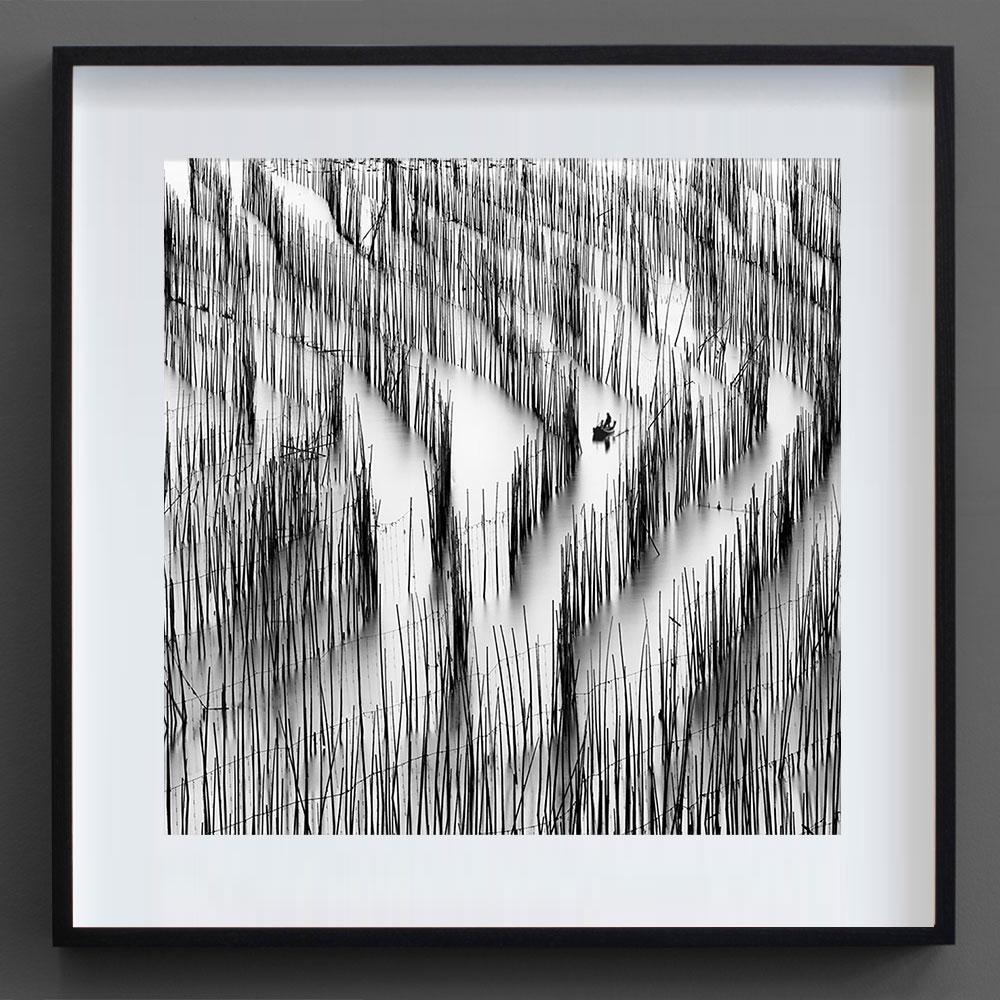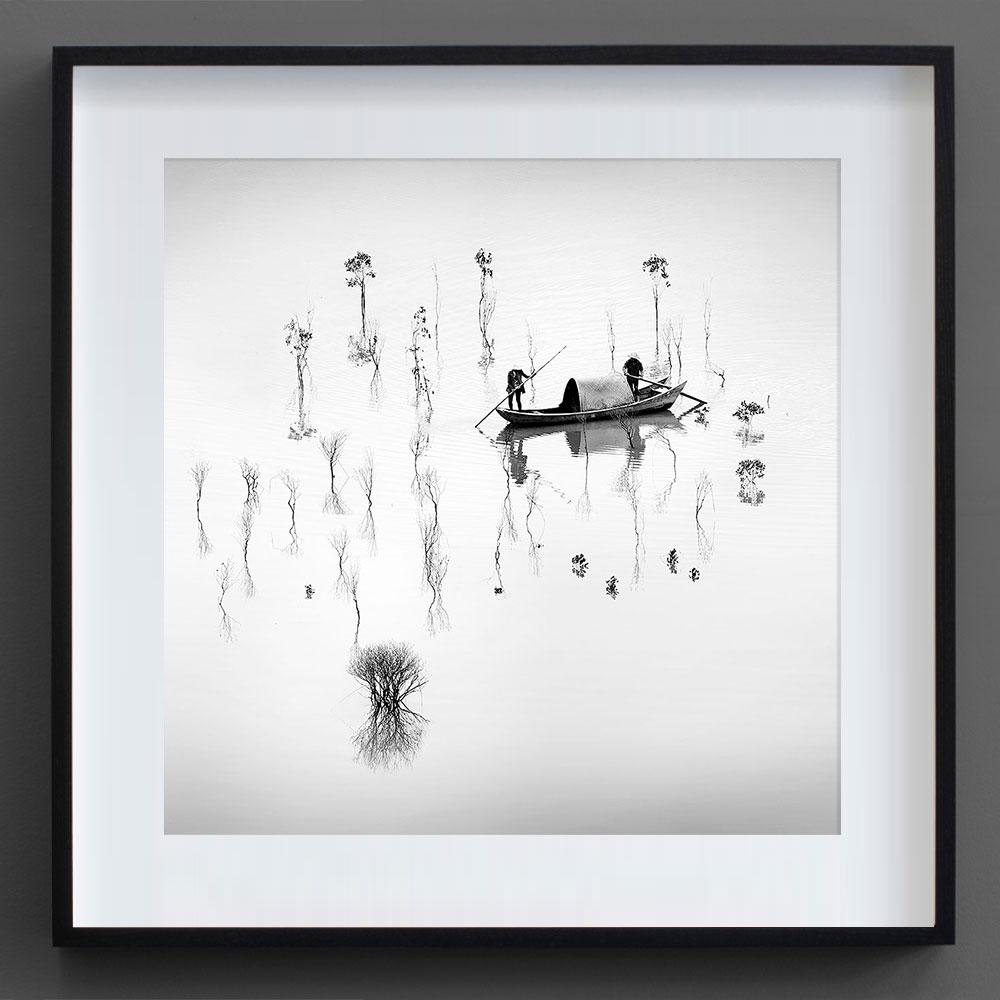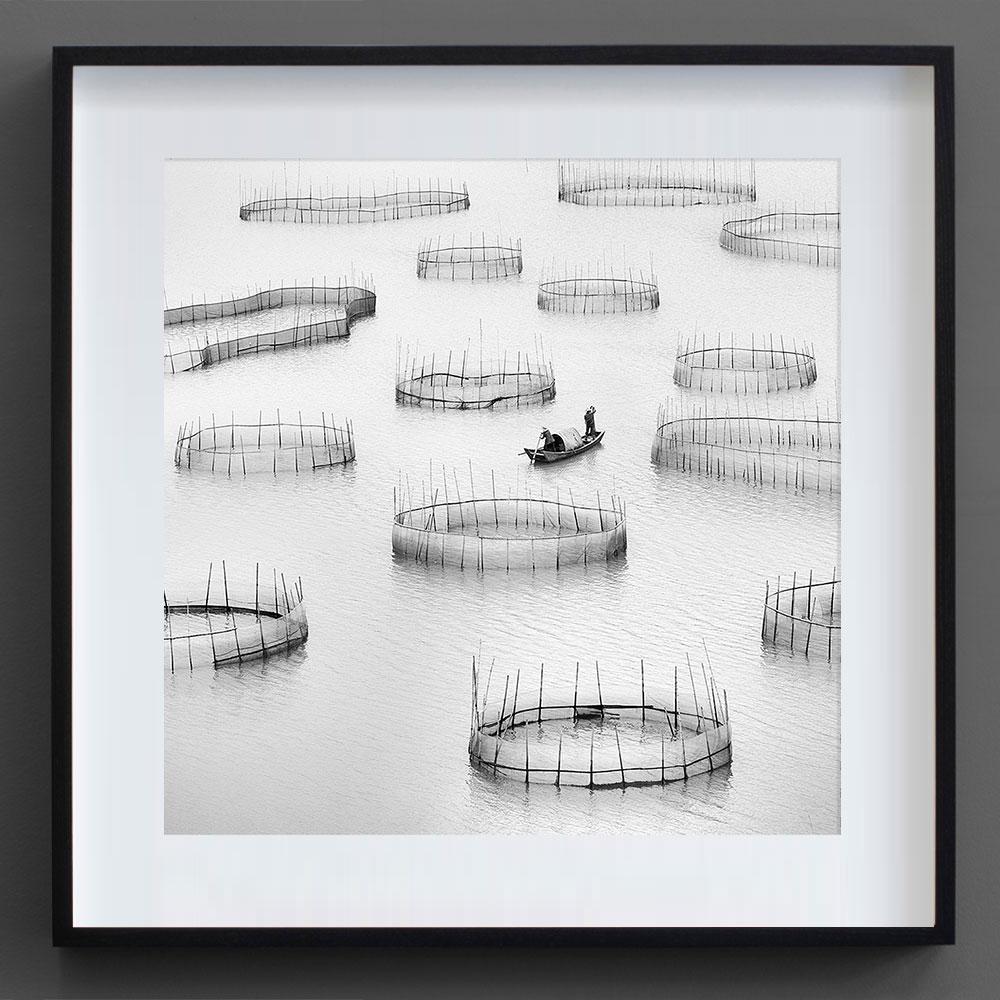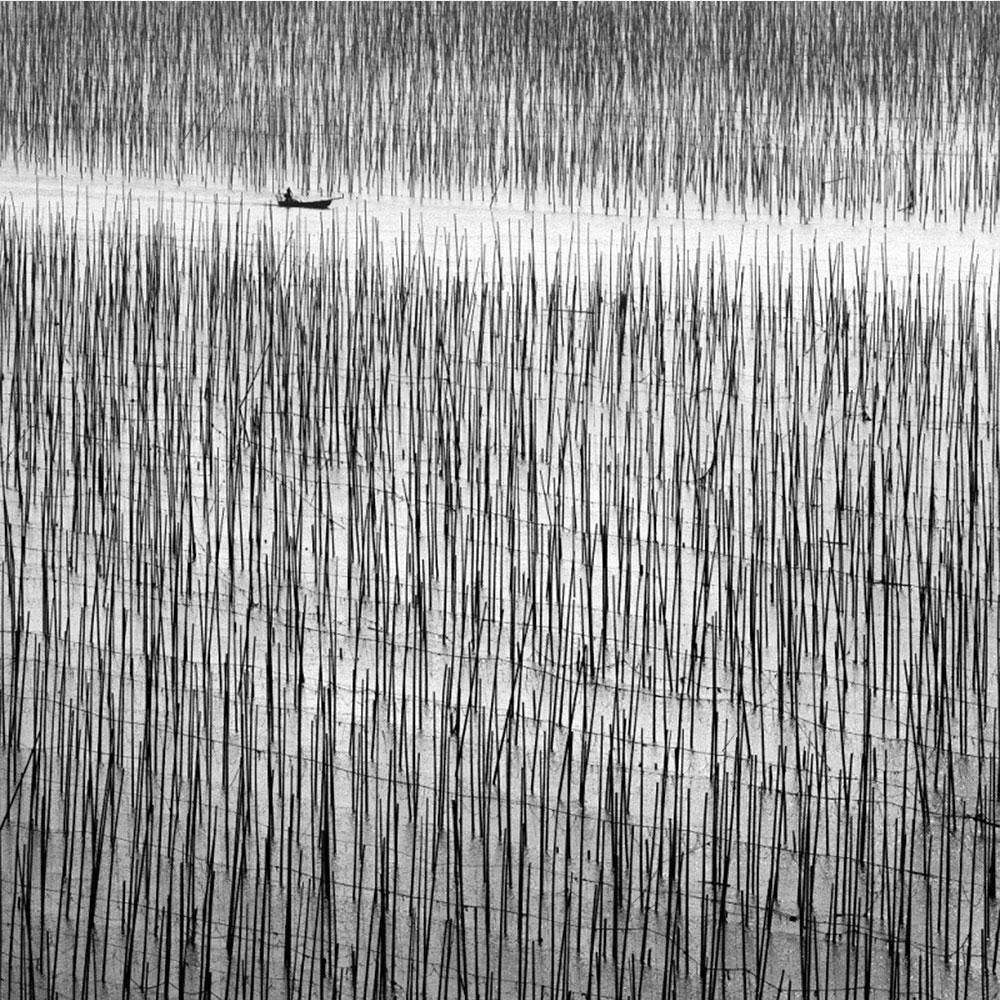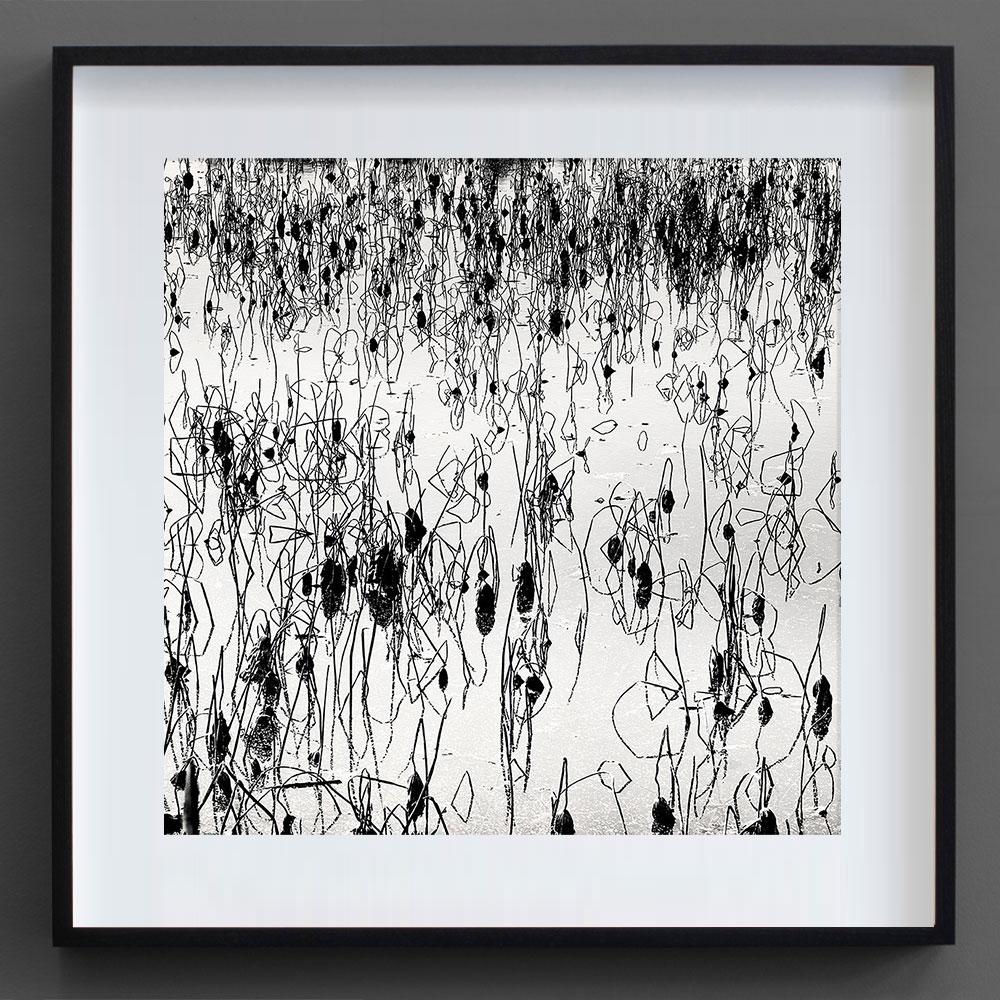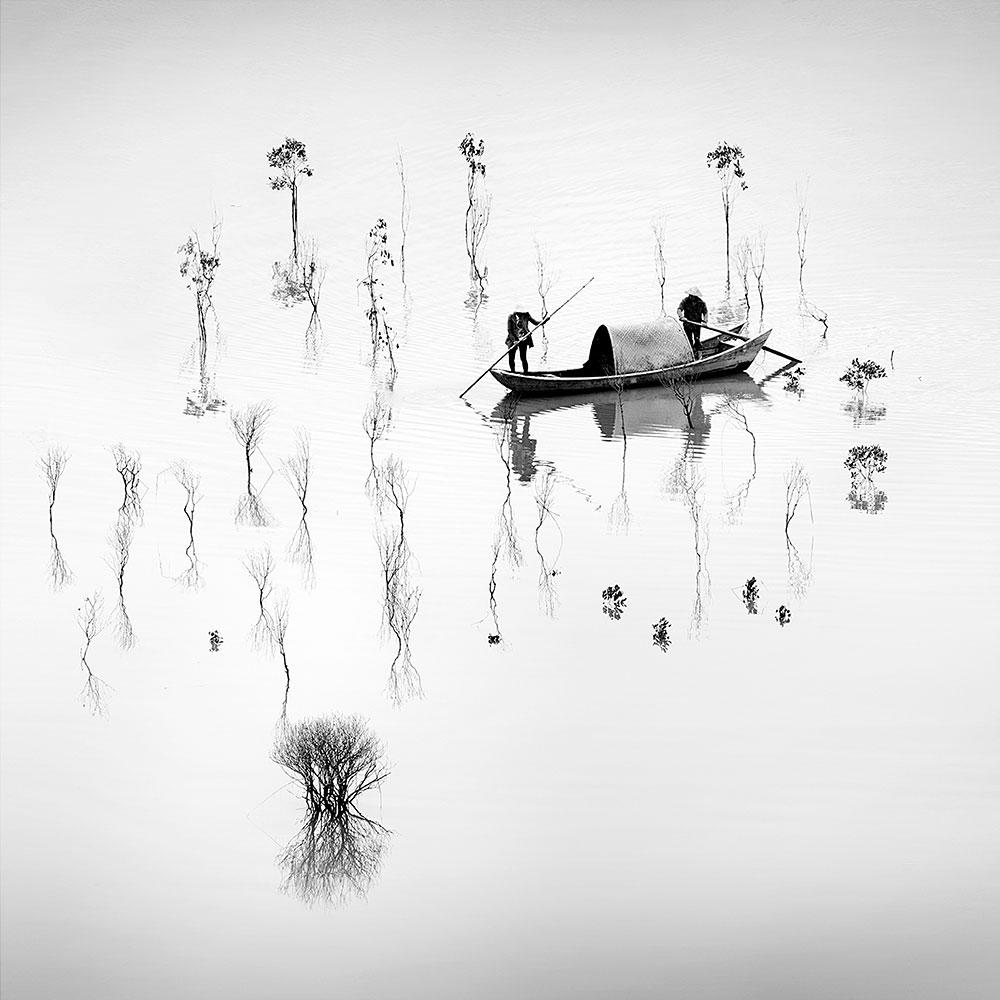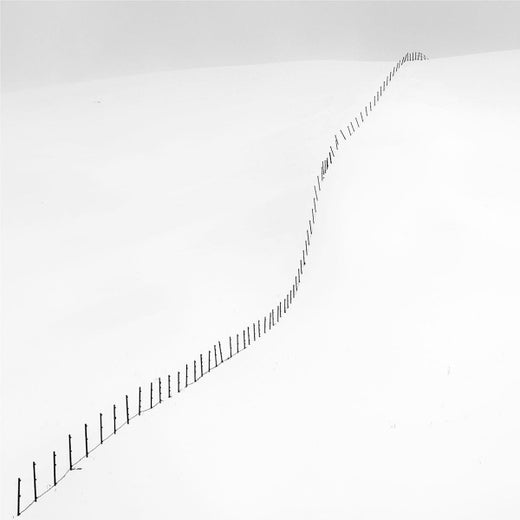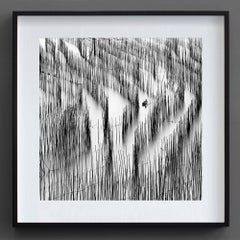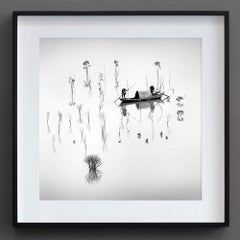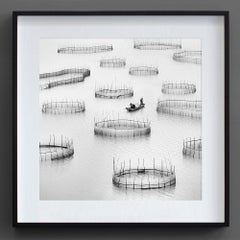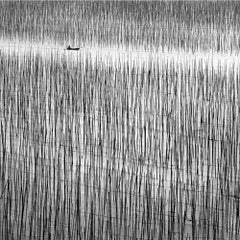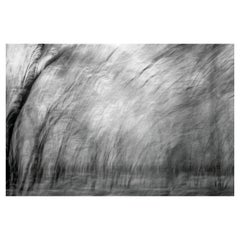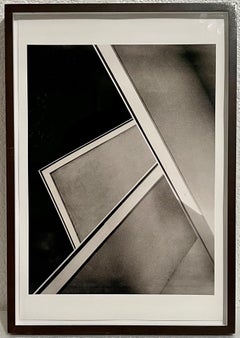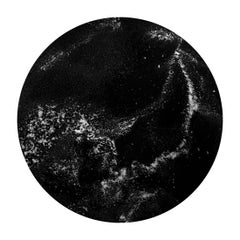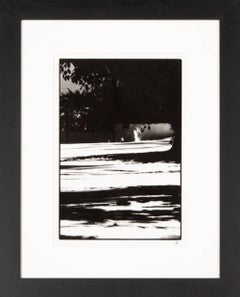Items Similar to Lost in Abstraction 2, China (B&W Photography)
Want more images or videos?
Request additional images or videos from the seller
1 of 6
Alexandre ManuelLost in Abstraction 2, China (B&W Photography)2017
2017
$2,950
£2,253.64
€2,588.91
CA$4,223.61
A$4,620.15
CHF 2,407.16
MX$55,590.83
NOK 30,483.49
SEK 28,621.07
DKK 19,332.83
About the Item
Alexandre Manuel
Lost in Abstraction 2, China, 2017
20x20 in (50x50cm) - Edition of 10
Archival Pigment Print
Image size 20x20inches (50x50cm)
Framed size: 28x28inches (70x70cm)
Mounted and framed with museum-quality, non-glare glass
In this quietly arresting work, Alexandre Manuel captures the fragile dialogue between nature and human presence. Drawing on his background in visual semiotics, the artist transforms landscape into language, each image a meditation on time, space, and memory.
Through long exposure and an acute sensitivity to light and atmosphere, Manuel renders the natural world with a stillness that feels both timeless and immediate. Traces of humanity, stone, structure, shoreline, are never dominant, but always present, suggesting a shared, silent continuity.
Framed to the highest conservation standards, this piece reflects Manuel’s rare ability to merge intellectual depth with visual serenity. A landscape not merely observed, but deeply felt.
- Creator:Alexandre Manuel (1979, Portuguese)
- Creation Year:2017
- Dimensions:Height: 28 in (71.12 cm)Width: 28 in (71.12 cm)Depth: 2 in (5.08 cm)
- Medium:
- Movement & Style:
- Period:
- Condition:
- Gallery Location:New York City, NY
- Reference Number:Seller: AM221stDibs: LU1014316610972
Alexandre Manuel
ALEXANDRE MANUEL: EXPLORING THE LIMITS OF THE LANDSCAPE Born in 1979 in the Franche-Comté region, straddling the borders of Switzerland and France, Alexandre Manuel is an artist whose work has evolved into a profound investigation of the visual language and semiotics of photography. Now based in Portugal, Manuel holds a doctorate in Visual Semiotics, specializing in printed photography. A distinguished academic, he is also an auxiliary professor at several universities, having earned this title through the recognition of the French Ministry. Despite his academic achievements, Manuel’s passion for photography has always driven him to dedicate his life to the medium, where his visual exploration of nature and the human experience continues to evolve. THE LIMITS OF THE LANDSCAPE Manuel’s photographic practice revolves around the interrogation of landscape, particularly its limits and boundaries. Through his refined technique and use of long exposure, Manuel captures natural landscapes that convey a delicate tension between absence and presence. His images evoke an existential dialogue between humankind and the environment, drawing attention to the fragile relationship between man and nature. These visual statements probe the natural evolution of landscapes—often untouched by human intervention—and highlight their permanence or impermanence within the context of human experience. TIME AND SPACE IN PHOTOGRAPHY At the core of Manuel’s work is a fascination with temporality. His long exposure techniques, coupled with his understanding of atmospheric conditions, allow him to craft images that evoke a sense of serene timelessness. Manuel seeks to create spaces that are not merely representations of the natural world, but evocative landscapes where time becomes fluid, and the viewer’s imagination is free to wander. The tranquility of his work is underscored by the subtle presence of human influence, whether in the form of structures, rocks, or maritime locations—suggesting a continuity between humanity and nature, as they coexist in a quiet, unspoken harmony. A CONTINUOUS SCENE OF PEACEFULNESS In his own words, Manuel states, "I try to create a continuous scene that is untouched by time and only framed by traces of human contact in structures, rocks, and maritime locations." This approach reflects his desire to depict landscapes that transcend the constraints of time, offering a moment of stillness where the viewer can experience nature in its most pristine form. His photographs not only capture the beauty of the natural world but also invite reflection on the enduring, yet fragile, connection between humanity and the landscapes it inhabits.
About the Seller
5.0
Vetted Professional Seller
Every seller passes strict standards for authenticity and reliability
Established in 2010
1stDibs seller since 2018
46 sales on 1stDibs
Typical response time: 1 to 2 days
- ShippingRetrieving quote...Shipping from: Miami, FL
- Return Policy
Authenticity Guarantee
In the unlikely event there’s an issue with an item’s authenticity, contact us within 1 year for a full refund. DetailsMoney-Back Guarantee
If your item is not as described, is damaged in transit, or does not arrive, contact us within 7 days for a full refund. Details24-Hour Cancellation
You have a 24-hour grace period in which to reconsider your purchase, with no questions asked.Vetted Professional Sellers
Our world-class sellers must adhere to strict standards for service and quality, maintaining the integrity of our listings.Price-Match Guarantee
If you find that a seller listed the same item for a lower price elsewhere, we’ll match it.Trusted Global Delivery
Our best-in-class carrier network provides specialized shipping options worldwide, including custom delivery.More From This Seller
View AllLost in Abstraction 4, China (B&W Photography)
By Alexandre Manuel
Located in New York City, NY
Alexandre Manuel
Lost in Abstraction 4, China, 2017
20x20 in (50x50cm) - Edition of 10
Archival Pigment Print
Image size 20x20inches (50x50cm)
Framed size: 28x28inches (70x70cm)
Mou...
Category
2010s Contemporary Black and White Photography
Materials
Archival Pigment
Lost in Abstraction 7, China (B&W Photography)
By Alexandre Manuel
Located in New York City, NY
Alexandre Manuel
Lost in Abstraction 7, China, 2019
20x20 in (50x50cm) - Edition of 10
Archival Pigment Print
Image size 20x20inches (50x50cm)
Framed size: 28x28inches (70x70cm)
Mou...
Category
2010s Contemporary Black and White Photography
Materials
Archival Pigment
Lost in Abstraction 6, China (B&W Photography)
By Alexandre Manuel
Located in New York City, NY
Alexandre Manuel
Lost in Abstraction 6, China, 2019
20x20 in (50x50cm) - Edition of 10
Archival Pigment Print
Image size 20x20inches (50x50cm)
Framed size: 28x28inches (70x70cm)
Mou...
Category
2010s Contemporary Black and White Photography
Materials
Archival Pigment
Lost in Abstraction 2, China
By Alexandre Manuel
Located in New York City, NY
Lost in Abstraction 2, China, 2017
20 x 20 inches
Edition of 7
40x40 inches
Edition of 5
60x60 inches
Edition of 3
Ask us for framing options.
Category
2010s Contemporary Black and White Photography
Materials
Archival Pigment
Constellation, China, Lost in Abstraction (B&W Photography)
By Alexandre Manuel
Located in New York City, NY
Alexandre Manuel
Constellation, China, 2019
20x20 in (50x50cm) - Edition of 10
Archival Pigment Print
Image size 20x20inches (50x50cm)
Framed size: 28x28inches (70x70cm)
Mounted and...
Category
2010s Contemporary Black and White Photography
Materials
Archival Pigment
Lost in Abstraction 4, China
By Alexandre Manuel
Located in New York City, NY
Lost in Abstraction 4, China, 2017
20 x 20 inches
Edition of 7
40x40 inches
Edition of 5
60x60 inches
Edition of 3
Ask us for framing options.
Category
2010s Contemporary Black and White Photography
Materials
Archival Pigment
You May Also Like
Wildlife Landscape Photograph Nature Large Abstract Trees India Black White
By Aditya Dicky Singh
Located in Norfolk, GB
Aditya Dicky Singh Untitled Infrared photograph on fine-art Hahnemuhle archival paper
44 x 65" unframed (112cm x 165cm) 2022
Edition 1/8
*Shou...
Category
2010s Contemporary Black and White Photography
Materials
Archival Ink, Archival Paper
Brazilian Conceptual Modernist Photograph Jose Yalenti Architectural Abstract
Located in Surfside, FL
José Yalenti, (1895-1967) Brazilian Photographer
"Beiras" (Sides)
Photo, numbered 5/15, circa 1950, (printed later) on premium luster photo paper with ultrachrome ink.
Art: 15" H x 11" W; Frame: 20 1/4" H x 14 1/4" W.
Provenance: Dickinson Roundell Gallery
José Yalenti’s Architecture photos seem at first disorienting, abstract black & white and grey surfaces, cut through by startlingly straight lines and a variety of surface textures. Much of his work is of mid-century Latin American architecture, by the likes of Oscar Niemeyer and Roberto Burle Marx.
José Yalenti was born in São Paulo, Brazil in 1895. On April 28, 1939, a group of photography aficionados, including Yalenti, formed the Foto Clube Bandeirante, later changed to Foto Cine Clube Bandeirante, or FCCB.
Starting in the late 1940s, a contingent of FCCB photographers began creating photographs of abstracted architectural motifs (as in Architecture or Twilight), and eventually became known as the Escola Paulista, or “Paulista School.” Yalenti was among the members of the unofficial Paulista School. Between 1945 and 1960, the Paulista School photographers explored the rapidly changing formal qualities of São Paulo. By photographing skyscrapers and stairways at steep angles, creating closely cropped compositions from found geometric motifs, and capturing the flattening effects of shadows, Paulista School photographers investigated the new physical perspectives emerging in the urban environment. They created a distinctively Modern aesthetic that used strong contrasts of light and dark, geometric forms, linear compositions, and collapsed space to assert photography’s status as an artistic medium.
As part of their pursuit of photographic Modernism, Yalenti and his fellow Brazilians adapted the stylistic innovations of U.S. and European photographers such as f.64, New Objectivity, Dada, Surrealism, and the Bauhaus, to the Brazilian context. Along with his FCCB compatriots—Thomaz Farkas, Geraldo de Barros, and German Lorca, among others—Yalenti explored the formal properties of black-and-white image-making.
Yalenti and the Paulista’s School’s abstract photographs responded to the new trends in Brazilian Modernist architecture being developed by young architects in São Paulo and Rio de Janeiro. In 1939, Lúcio Costa, Oscar Niemeyer, and Affonso Reidy broke ground on the Ministry of Education and Health Building (MES), the building that would define Brazilian architectural modernism. The Rio-based team combined elements of Le Corbusier’s undecorated structural purity with Brazilian regional design to produce a more organic and “tropical” Modernism that responded to the local culture and climate.
The sinuous and sensuous curves of Yalenti’s photograph are directly influenced by stylistic developments in architecture at the MES, including the building’s covered entry and its organically abstract contours. By 1957, when Yalenti created Architecture or Twilight, Brazil was globally recognized as an architectural leader. MoMA in New York City organized a popular exhibition of Brazilian architecture in 1943 (“Brazil Builds”), and highlighted the country again in its survey show "Latin American Architecture since 1945," that ran from 1955–56. Brazilian photography...
Category
20th Century Modern Black and White Photography
Materials
Photographic Paper
Interstellar II. Abstract. Black and White Print
By Shine Huang
Located in Miami Beach, FL
The galaxy like silver particles scattered on the giant black circle which floating in the square frame. That is a complexity of artist’s concept formation and culture practicing. In...
Category
2010s Minimalist Black and White Photography
Materials
Black and White, Archival Pigment
Landscape- black and white abstract silver gelatin print photography
By Bruce Frankel
Located in New York, NY
BRUCE FRANKEL
Untitled (Landscape)
13.5 x 9.25 inches; framed in black frame 21.3 x 17.1 inches
gelatin silver print
ink signed recto
Bruce Frankel captured this black and white photograph of an arboreal landscape emphasizing the striations of light that encompasses the foreground and contrasts with the darkness in the background.
Bruce Frankel is an acclaimed journalist who has routinely worked with the photographic image- 16 mn and super 8mn film...
Category
2010s Contemporary Black and White Photography
Materials
Silver Gelatin
Hangzhou, Zheijiang, China
By Lois Conner
Located in New York, NY
Lois Conner
Hangzhou, Zheijiang, China, 1998
Pigment ink on Hahnemühle cotton paper
17 x 35 1/2 inches (sheet)
29 3/8 x 45 3/4 inches (frame)
AP 3
Signed
Category
Late 20th Century Contemporary Abstract Photography
Materials
Rag Paper
Cristian Stefanescu, Monochromatic #02, Contemporary Black & White Statement Art
By Cristian Stefanescu
Located in Deddington, GB
Cristian Stefanescu
Monochromatic #03
Black and White Abstract Geometry, Limited Edition Digital Photograph
Edition of 30
Artists Proofs 3
Ultra HD Photo Prints On Aluminium Dibond developed on matte Fuji Crystal Professional Archive Maxima photo paper. The matte surface prevents glare; surfaces are laminated with a UV protective film that makes them resistant to light.
Image Size: 60 cm x 90 cm x 2 cm
Sold Unframed
Arrive Ready to Hang (integrated wall-mounts on the back using aluminium rail rectangle)
Free Shipping
Please note that in situ images are purely an indication of how a piece may look.
Monochromatic #02 is part of a series of photographs entitled Monochromatic by Cristian Stefanescu. This black and white abstract geometry series is presenting a dialogue with the elements of perceptions and space. Seeing is unconscious using our senses, our intellect and our emotions in order to interpret the world around us according to our own personality, frame of reference or system of beliefs.
I like to use as starting point the elements already created in our reality, fragments of nature or made by human hand. I like to restructure the images I am taking, by altering the angles and relative lengths, joining structures or spatial symbols into a combined representation of matter, just as I like to reorganise my thoughts, in order to be able to change my interpretation, or better say my perception and while doing so I add new forms or perspectives to each thought.
Cristian Stefanescu, artist, is available for sale online and in our art gallery at Wychwood Art. Oxford based artist Cristian Stefanescu was born in 1968 in Bucharest. He obtained an MSc degree in 1992 at the Technical University of Construction Bucharest, specialisation in Water and Wastewater Treatment followed by the second MSc in 1994 obtained at University of Liège, specialisation in Groundwater Engineering. After having spent more than a decade of his life teaching at the Technical University of Construction Bucharest, Cristian moved from academia to photography working in fashion industry. The passion for photography developed in the early years of college and became a constant element of his life. After long and constant collaborations with fashion brands in Romania, in 2018 Stefanescu moved to London to open his own studio. Photography was born black and white and he chose to continue this tradition, while working on evolving the visual aesthetics of this raw art form rendering his believes. Cristian Stefanescu’s distinctive monochrome photographs are an exploration into the psychological and metaphysical. He captures nature or buildings in specific moments in time – through highly visual heartbreakingly dark images often overlapped with low-contrast minimal landscapes – to create works that stretch the idea of a hypothetical time. His photo installations exist in dialogue with the elements and perceptions of space and time. “Seeing is unconscious using our senses, our intellect and our emotions in order to interpret the world around us according to our own personality, frame of reference or system of beliefs.” he has said. “I like to use as starting point the elements already created in our reality, fragments of nature or made by human hand. I like to restructure the images I am taking, by altering the angles and relative lengths, joining structures or spatial symbols into a combined representation of matter, just as I like to reorganise my thoughts, in order to be able to change my interpretation, or better say my perception and while doing so I add new forms or perspectives to each thought. This is perhaps why I love photography, because it is simply a visual capture of something already created in the world and is always changing through our interpretation, it is more like a reflexion of our thoughts.” Always preferring to focus on the space rather than its subjects Stefanescu is obsessive about the contrast of his photography, in order to channel the intensity of light and texture of the storied buildings or nature elements. He documents concrete buildings, using the subject as representative for its physical referents, while considering metaphorically the world as the concrete representation of our emotions. Concrete thinking requires facts and representation about everyday life, palpable objects in a tree dimensional world. Stefanescu uses his photographs to deconstruct and alter reality in order to obtain abstract images, since by definition the abstract thinking involves a mental process and an abstract object does not exist in time or space, but rather exists as a thought, as an idea. “I use art in a reversed process of creation. I believe thought forms what our eyes can see, so I take what was already created by the thought of another and I try to place it back into what is known forever in the mind” he has said. Cristian Stefanescu believes in the energy of every being, of each object or nature element. He upholds that photography renders the ineffable combination of the object’s energy and the photographer’s one while taking a picture. And what is the energy of a photograph? Is it the energy of the space that is framed in the viewfinder, is it the energy of the photographer? I think it is an ineffable combination of the photographer’s energy when he pressed the shutter button and everything that forms the energy of the photographed space...
Category
21st Century and Contemporary Contemporary Black and White Photography
Materials
Metal
More Ways To Browse
Framed Chinese Prints
Wizard Of Oz Art
Agatha Christie
Alaia Photography
Ansel Adams Yosemite Print
Bob Dylan Photograph
Byzantine Relief
Cuban Cigar Art
David Armstrong Print
David Crosby
Dee Dee Ramone
Dirty Harry
Eartha Kitt
Edie Sedgwick Photography
Grateful Dead Photography
Guitar Girl
Honor Blackman
Houston Skyline
